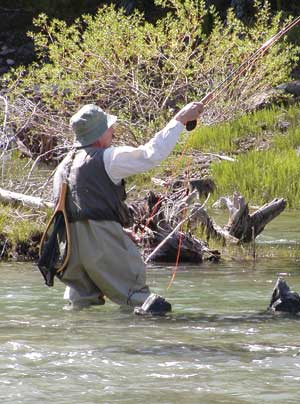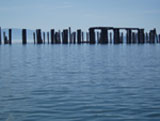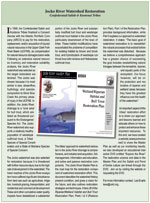Fishing
The Flathead Watershed is an angler’s paradise. Some of the greatest trout fishing water in some of the most breathtaking scenery in North America are located within the watershed. Fishing is most popular in spring, summer, and fall, but even the winter offers lake ice fishing opportunities. Fishing season for rivers and streams opens the third Saturday in May and closes November 30, but anglers must check regulations for catch-and-release rules, spawning closures, extended catch-and-release-seasons, and restrictions on fishing during low flow. Lakes are generally open year round. Anglers should check current conditions and approach all water with care and respect, and use best practices to prevent the spread of aquatic invasive species.
Two native Flathead Watershed fish—bull trout (Salvelinus confluentus) and westslope cutthroat trout (Oncorhynchus clarkii lewisi)—have been part of the watershed landscape for over 14,000 years. Both species have the potential to exhibit three life history strategies: adfluvial, fluvial, and resident. Adfluvial fish reside in lakes as adults and return to headwater streams to spawn. Fluvial fish reside in larger free-flowing streams or rivers as adults and return to headwater streams to spawn. Stream resident fish spend their entire life cycles in flowing waters and spawn in the headwaters of the streams they inhabit. Bull trout in particular have an adfluvial life form, which means they spend time in Flathead Lake growing to adulthood until they are sexually mature. Once they are ready to spawn—at 4 to 6 years—they migrate into tributary streams, some traveling over 150 miles. Once their fry (young fish) emerge from their gravel spawning grounds, juveniles will rear in the streams for one to three years before migrating back to Flathead Lake. With the exception of a few water bodies, it is illegal to intentionally fish for or take bull trout which have been listed as “threatened” since 1998 by the U.S. Fish and Wildlife Service under the Endangered Species Act.
 |
| Fishing the Flathead Rivers. Source: Lori Curtis |
While many fishing hot spots are easily accessed, some wilder areas offer greater solitude and better angling but require more work to access. Long drives on rough roads and strenuous hikes are required to reach some of the best destinations. Many fishing areas are located in grizzly bear habitat where anglers are required to hang or protect their food in bear proof containers, and encouraged to be “bear aware.” There are many lakes and rivers to explore in the Flathead Watershed, but here are a few well known ones.
Flathead River
The North and Middle Fork Flathead Rivers are fed mostly by glacial meltwater and groundwater running over rock that contributes little in the way of fish-supporting nutrients. However, native westslope cutthroat trout, bull trout, and mountain whitefish are present in the North Fork, Middle Fork, and South Fork of the Flathead River. Non-native rainbow trout are becoming increasingly common in the lower portion of the North and Middle Forks of the river, much to the detriment of the native cutthroat trout. Nonnative lake trout are invading more of the headwater lakes, much to the detriment of bull trout.
Kokanee became functionally extinct in Flathead Lake and westslope cutthroat and bull trout declined as a result of the introduction of opossum shrimp (Mysis relicta) in upstream lakes in the 1960s and 1970s. The shrimp drifted downstream into Flathead Lake and consumed most of the zooplankton creating conditions conducive to lake whitefish and non-native lake trout production. The shrimp avoid visual feeders such as cutthroat trout by residing in the very cold water on the dark lake bottom during the daytime, but they have become good forage for more bottom dwelling fish like lake trout. At night the opossum shrimp migrate up in the water column, feeding on some of the same food items as juvenile native trout. As a result, the food for the cutthroat was reduced and predation by lake trout on juvenile cutthroat and bull trout has increased. The lake and river food webs of the area are constantly changing, and fisheries managers strive to restore the lake and river systems for naturally reproducing native fish.
The North Fork Flathead River originates in British Columbia, in the midst of the remote and scenic beauty of the Canadian Rockies. The river divides Glacier National Park from the Flathead National Forest, providing great fishing in both systems. The upper portion of the river is designated as “Wild and Scenic,” while the lower section before the confluence of the Middle Fork is “Recreational.” Fishing the North Fork offers opportunities for solitude in an extraordinarily picturesque setting. It is an excellent river for rafting, canoeing, or kayaking, but floaters should wait for runoff flows to recede, usually in July.
The Middle Fork Flathead River originates in the Great Bear Wilderness at the confluence of Strawberry and Bowl Creeks. Fishing can be good on the Middle Fork, particularly just prior to spring runoff when fish are migrating from Flathead Lake on their spring spawning runs. The Middle Fork is well known for some of the best whitewater rapids in Montana. With little pressure from anglers on this portion of the river, it presents excellent chances for secluded angling.
The South Fork Flathead River offers pristine surroundings and angling unspoiled by non-native fish. The South Fork originates at the confluence of Danaher and Youngs Creeks in the Bob Marshall Wilderness and flows north for 57 miles (92 km) into Hungry Horse Reservoir. The construction of Hungry Horse Dam in 1952 isolated native migratory fish but also prevented upstream invasion by introduced lake trout, so anglers on the South Fork are treated to native mountain whitefish and westslope cutthroat trout. Access to the river is difficult, requiring a long drive followed by some hiking to good fishing access. This challenging access keeps angler pressure low and leaves the fish eager to hit on a variety of flies.
The Swan River begins in the Swan Valley, flanked by the Swan and Mission Mountains and the Mission Mountain and Bob Marshall Wildernesses, and is one of the major tributaries flowing into Flathead Lake. The upper portion of the river flows through mountainous landscapes, willow-lined meadows, and sweeping marshlands before entering Swan Lake. It exits the lake flowing toward the town of Bigfork, widening as it flows downstream. Thick vegetation makes fishing difficult in the upper parts of the river, but between Swan Lake and Bigfork, floating is pleasant. About 1.25 miles (2 km) above Flathead Lake, the Swan River is impounded by the Bigfork Dam. In addition to supplying hydropower, the dam helps create class III and IV whitewater rapids, known locally as the “Wild Mile.” Rafting and kayaking enthusiasts enjoy this section of the river, as do anglers seeking rainbow trout.
 |
| (click to enlarge) Figure 4.14: Flathead Lake Fishing Guide. Source: Montana Fish, Wildlife and Parks/Confederated Salish and Kootenai Tribes |
Flathead Lake
Fishing is popular on Flathead Lake, the largest freshwater lake west of the Mississippi River. Lake trout, lake whitefish, yellow perch, and cutthroat trout are present. Some bull trout are present in the lake but it is illegal to fish for or take them. While average lake trout caught are typically in the three to eight pound (1.4 - 3.6 kg) range, they can reach enormous sizes—often exceeding 20 pounds (>9 kg). The lake whitefish usually weigh 3 to 4 pounds (1.4 - 1.8 kg). Most of the year, fishing is done by boat as the lake trout are found in deeper waters of the lake. In fall, the trout swim near the shoreline, enticing shore anglers. There are numerous state parks, and boat and shore access sites.
 |
| Figure 4.15: Flathead Lake Fish Species Chart. Source: Whitefish Lake Institute, based on Delcray, 1999 |
Handkerchief Lake
Handkerchief Lake is located in the South Fork Flathead River drainage. Westslope cutthroat trout and non-native arctic grayling are present. The best fishing on this lake is just after the ice melts around mid-May, and is best accessed by float tubes and canoes.
Jewel Basin Lakes
There are over 20 high mountain lakes in the Jewel Basin, several which are stocked with cutthroat trout on a three-year rotation. Non-native rainbow trout and Yellowstone cutthroat trout are present in several lakes as a result of early introductions in the 1930’s. A management plan is underway to replace hybrid cutthroat trout with pure westslope cutthroat trout to help maintain the native fish assemblage in the South Fork Flathead River. Easy access places angling stress on the Jewel Basin lakes. The lakes present a welcome respite from the summer heat in the valley. Highest catch rates are just after ice-off and in the fall.
Swan Lake
Swan Lake offers good trolling for kokanee in the summer, northern pike and yellow perch in the springtime and trout in the fall. Swan Lake is the only place where anglers may catch and keep one bull trout per day with a general fishing license. The lake has easy fishing access for boaters and from the shoreline.
Whitefish Lake
Whitefish Lake is located in the community of Whitefish, below Whitefish Mountain Resort ski area. Lake trout, northern pike, and of course the namesake mountain whitefish are present. Lake trout average 1 to 3 pounds (.45 to 1.4 kg) but can exceed 20 pounds (9 kg). Most fishing is done by boat trolling and near inlets at the northern end of the lake. Although the lake is surrounded by summer homes and condominiums, there is good access for anglers.
Hungry Horse Reservoir
Prior to Hungry Horse Dam, the South Fork Flathead River was connected to the Flathead River system. Bull trout and westslope cutthroat trout migrated from Flathead Lake to spawn and rear in the South, Middle, and North Fork tributary streams. Hungry Horse Dam now blocks the upstream passage and 40% of the available spawning area for bull trout and westslope cutthroat trout that used to migrate from Flathead Lake. Fish from the South Fork can no longer return to Flathead Lake, but instead use the reservoir to rear and reach maturity. Bull trout, westslope cutthroat trout and mountain whitefish are present. The reservoir is open year round and there is good access for boats. Hungry Horse Reservoir is one of the few waters in the U.S. where it is legal to fish for bull trout with the proper permits. The closed reservoir system has benefitted bull trout populations by partially isolating them from lake trout and other non-native fish.
| Resources | |
| Flathead National Forest Hungry Horse Ranger District http://www.fs.usda.gov/flathead 406.387.3800 |
Confederated Salish & Kootenai Tribes Fish, Wildlife, Recreation, and Conservation Division http://www.cskt.org/tr/fwrc.htm Flathead Lake Fishing Guide http://fwpiis.mt.gov/content/getItem.aspx?id=11216 406.675.2700 |
Montana Fish, Wildlife & Parks |
U.S. Fish & Wildlife Service |





